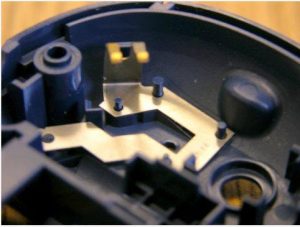
Why Use Heat Staking for Plastic Assembly Projects?
While multiple industrial processes for high quality plastic assembly exist, heat staking continues to earn a significant amount of market share for the sectors. While the industrial products of yesteryear were attached using hardware fasteners, this practice has become obsolete once heat staking technology became the industry standard.
Heat Staking eliminates the need for extra hardware, which can become defective, break, or otherwise suffer from quality control issues. Additionally, hardware fasteners tend to be more expensive and labor intensive than heat staking plastic fastening options.
Plastic Assembly with Heat Staking – How Does It Work?
Heat staking technology is quite simple in concept. Whenever two or more components need to be attached to one another, and at least one is made of a thermoplastic, a combination of heat and pressure can be used to reform the plastic to the many shapes or profiles to retain or join the parts together.
This creates a solid, hardware-free bond that uses the plastic’s inherent strength to keep the finished assembly together.
The main advantage to heat staking, when compared to fastener-based technologies, is that manufacturers can perform all heat staking in one machine cycle and motion versus individual motions required for each fastener. A secondary benefit is that the manufacturers do not need to change the base material – it can remain “AS-IS” while the plastic is heat staked to conform to its final dimensions.
Unlike ultrasonic plastic assembly, which uses high-frequency vibrations to generate the heat necessary to bond plastic components to one another, heat staking is safe to use with a broad range of electronics and produces a higher pull strength versus the ultrasonic technique. Ultrasonic vibrations have been known to effect or damage sensitive electronic components and cause cold solder joints or stress cracks in the printed circuit boards.
Heat staking technology, on the other hand, creates almost no mechanical stress because it operates through a precise control and application of the temperature and pressure to cause the reforming of the plastic that it makes contact with. Even glass-filled plastics can be reliably joined using this method of heat staking – which is not the case for cold staking or other techniques.
The fact that heating is completely localized within a small area means that electronics are safe from damage. Thermal Press’ plastic assembly machines can operate very precisely within the small process temperature windows, as demanded by the most delicate and the most difficult thermoplastics used in todays’ high-end medical, automotive, telecom and consumer products.
What Materials Are Best Suited for Thermal Press?
Heat staking technology is ideal for most native and blended thermoplastics on the market today, as well as the most robust glass and/or other-filled plastics. It produces high quality results when used with any of the following materials:
- Polycarbonate (PC)
- Polypropylene (PP)
- Polystyrene (PS)
- Acrylonitrile butadiene styrene (ABS)
- Nylons (GFN or Nylon6/6)
- Ultem (GFN or Nylon6/6)
This makes heat staking ideal for heat staking LED Stamped Arrays or LED Flex Circuits into the plastic housings for OEM automotive and aerospace industries. Heat staking is also the preferred process in many medical device assembly applications for attaching adhesive patches to wearable glucose monitor devices and wearable medicine dispense devices versus the more brittle feel of an ultrasonic welded patch against the patient’s skin. The ability to also easily transition to multiple assemblies per machine cycle makes heat staking a very desirable and controlled production equipment option versus other technologies.
When looking for heat staking plastic assembly machines and tooling, be wary of very inexpensive options – cheap or “low-cost” machines cannot be expected to maintain their temperature and motion consistently throughout the entire production run. Heat staking machines need to operate at a precise temperature, motion and force to ensure the “sweet spot” is maintained for optimum heat staking results, which occur below the thermoplastics melt temperature to maintain the most effective and repeatable assembly process.